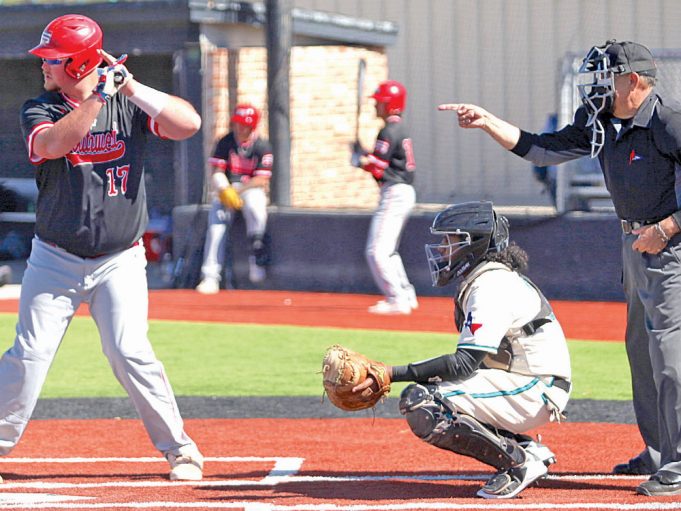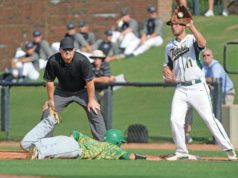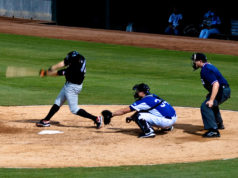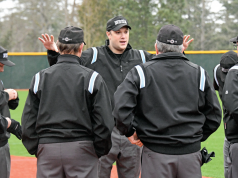In the 1984 College World Series, I had the plate in a semifinal game. Pitch one was a slider on the edge of home plate. Right in my wheelhouse, but I called it a ball, and instantly knew I was wrong. Oh, well, I thought — the burden of trying for a perfect game was gone. Pitch two was in the same spot. Same result.
I was determined not to miss another one. So here came a fastball about a foot high and outside. The problem was mentally I had called it a strike before it left the pitcher’s hand. As the third-base coach landed after jumping three feet high, I thought, “Bubba, you’re 0-for-3. Better get your head on straight.”
Any umpire can probably sympathize, for we’re all going to have moments — or games — where we can’t tell a ball from a strike. It happens at all levels and to veterans and newbies alike. Indeed, in the game above I had roughly 15 years of college and pro ball under my belt. External forces — bad pitching, weather, catchers who shift late, etc. — may be a factor, but often our problems are our own making. What to do when it’s a rough day?
Take inventory. Run down a checklist of basics. Timing too fast? Your head ought to be at the top of the batter’s strike zone; is it higher or lower, and are you keeping it steady as the pitch comes in? Tracking the pitch all the way to the mitt with your eyes? Something about your stance amiss? Maybe ask a partner for help; sometimes they see things we don’t.
Once, the head coach of a school for which I assigned non-conference games called about an umpire he said was missing pitches badly. To oblige him, I looked at video. Sure enough, the umpire’s head shifted to the other side of the catcher’s head on outside pitches to left-handed batters; because he wasn’t seeing the pitch all the way in, he was guessing and ringing up pitches a foot outside. At first he didn’t believe he was doing this, but after he saw the video it was a quick fix.
Don’t experiment. I once worked with a veteran who was inconsistent early in an NCAA regional game. He usually worked a box stance and obviously knew things were amiss because he shifted to a knee, scissors, back to a box, etc., to try to fix it. After the second inning he called me in and asked if I could help. I suggested he stick with his usual stance, keep his head steady and try the pro umpire school mantra of “On the rubber, get set, call it” before each pitch to get a consistent rhythm going. Ultimately, he got in the groove.
Presumably you’ve developed a stance and routine that have produced good results. Don’t change things if the going gets rough, for mid-game isn’t the time to experiment. Instead, try to figure out what you’re not doing that you usually do. Experiment in scrimmages.
Relax. At times when I struggled, I tensed up. Golfers know if you hit a few bad shots the impulse is to grip the club tighter, and this can happen to us. The more we mess up, the more rigid we may get. If you sense this, take a deep breath and try to feel the tension ease out of your body. You can’t hit good golf shots when you’re tense, and you can’t call balls and strikes that way. I’ve seen umpires who were so rigid, it seemed they’d been embalmed.
Don’t fidget around between pitches. I’ve seen umpires paw the dirt, grab their belt, adjust their mask or protector, etc., instead of just calmly standing there. I’ve also seen people jerk down into their stance as the pitcher is delivering. In terms of focus and timing, it’s better to ease down in a cruise-control manner. Watch major league umpires and you’ll see virtually all of them do this.
Focus. Sometimes we screw up because we’re not concentrating on the pitch all the way to the mitt. Maybe we’re unwittingly thinking about something else — a work problem, someone in the stands, etc. When I forced myself to block everything out and focus on the little white ball, it helped.
Don’t anticipate. I had to fight anticipating what pitch was coming given the situation. Once, the home team was ahead in the top of the ninth with two outs and an 0-2 count on the hitter. I was looking for a waste pitch, and here came what seemed like a high fastball. Unfortunately, it broke into the heart of the zone, but I had already registered it as a ball. Thankfully, the batter swung at the next pitch and missed. So if you’re having difficulties, it may be that you’re not taking each pitch as it comes without preconceived notions of what it will be.
Don’t be too fine. Pitchers can be too fine, and so can we. Sometimes it seems that we won’t ring up a pitch unless it’s perfect. My philosophy was that when a ball leaves the pitcher’s hand, it’s a strike until I’m convinced otherwise. Thus, I called borderline pitches strikes instead of making them be “right there.” If you’re having a rough day, ask yourself if this is the problem.
Have a short memory. It can be hard to do this, but if you know (or think) you missed a pitch, quickly turn the page. Stewing on the one that got away from you makes it more likely that you’ll boot the next one.
When I took inventory in my CWS game, I realized I missed the first two pitches because I had set up farther inside than usual and at an angle that made them look a mile outside. And my timing was fast. I missed the third one because I overreacted to the first two misses, anticipated another strike and didn’t process where it actually was. In other words, I butchered just about everything. Once I fixed things and calmed down, everything was OK. Mercifully.
What's Your Call? Leave a Comment:
Note: This article is archival in nature. Rules, interpretations, mechanics, philosophies and other information may or may not be correct for the current year.
This article is the copyright of ©Referee Enterprises, Inc., and may not be republished in whole or in part online, in print or in any capacity without expressed written permission from Referee. The article is made available for educational use by individuals.


















